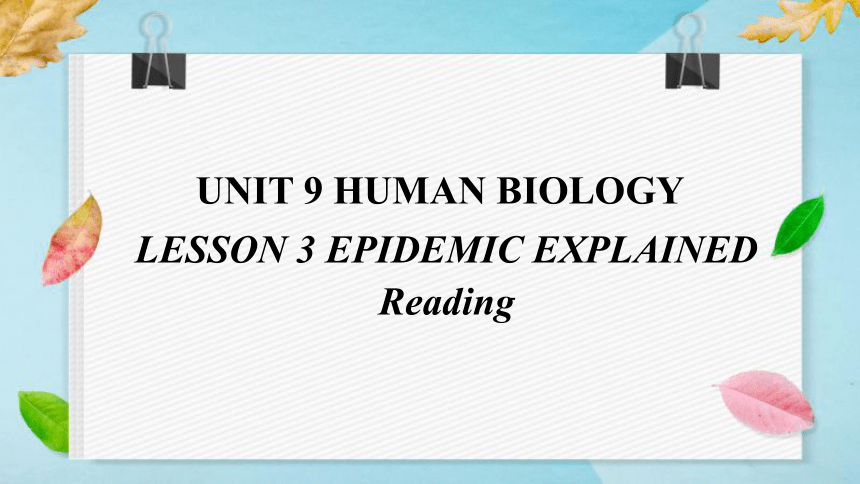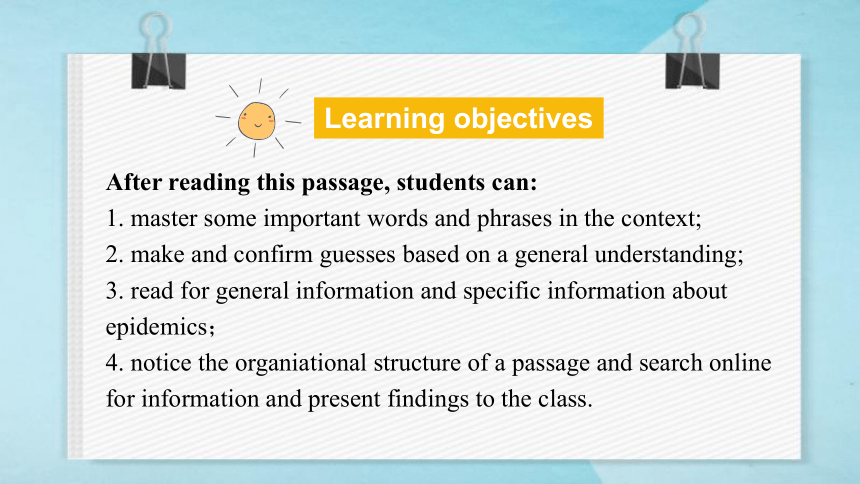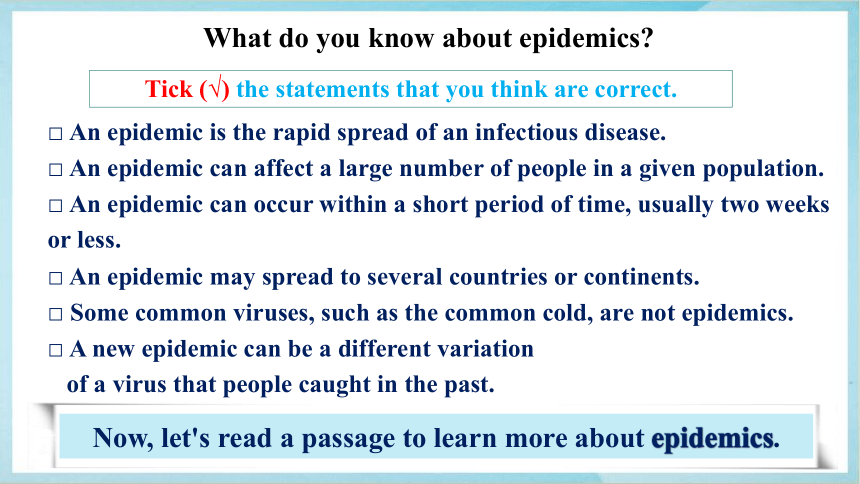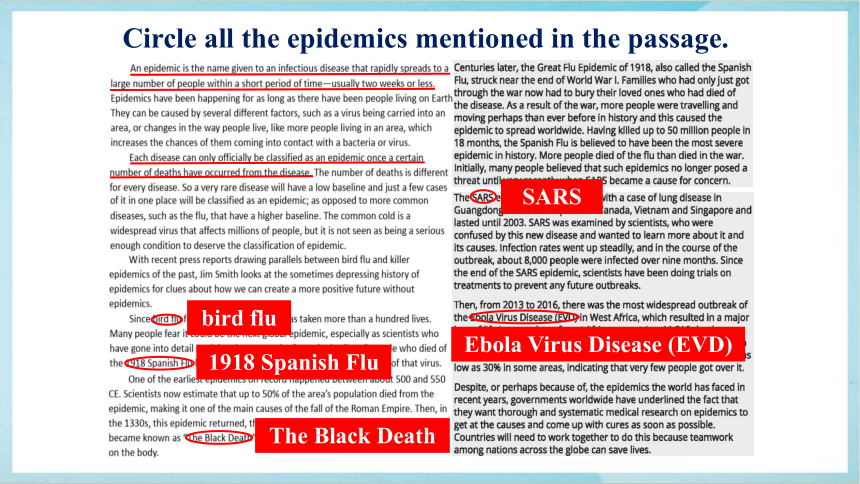Unit 9 Human Biology Lesson 3 课件(共17张)2024-2025学年高二英语北师版(2019)选择性必修3
文档属性
| 名称 | Unit 9 Human Biology Lesson 3 课件(共17张)2024-2025学年高二英语北师版(2019)选择性必修3 |  | |
| 格式 | pptx | ||
| 文件大小 | 3.3MB | ||
| 资源类型 | 教案 | ||
| 版本资源 | 北师大版(2019) | ||
| 科目 | 英语 | ||
| 更新时间 | 2025-05-01 16:34:32 | ||
图片预览







文档简介
(共17张PPT)
LESSON 3 EPIDEMIC EXPLAINED
Reading
UNIT 9 HUMAN BIOLOGY
Learning objectives
After reading this passage, students can:
1. master some important words and phrases in the context;
2. make and confirm guesses based on a general understanding;
3. read for general information and specific information about epidemics;
4. notice the organiational structure of a passage and search online for information and present findings to the class.
Do you know the following words and phrases after the preview
1.在短时间内____________ 2. 和……接触___________
3.将……分类_________________ 4. 一定数量的________________
5. 与sth相反____________ 6. 创造一个更美好的未来________________
7. 详细叙述__________ 8. 有记载/记录的 ___________
9. 度过/熬过困难时期___ 10.构成威胁_____________
11. 感染率 _________ 12.在……的过程中____________________
13. 作为……的结果 ___________ 14.导致 ___________
15. 从……中康复过来 _____ 16. 查明/发现___________________
17. 提出/想出_________________ 18.在全球范围内_________________________
19. 媒体报道 _ 20.将……和……相提并论 ______________
within a short period of time
come into contact with
be classified as
a certain number of
as opposed to
creative a more positive future
go into detail
on record
in the course of
get through
pose a threat
infection rates
as a result of
result in
get over
get it
come up with
across the globe
press report
draw parallels between...and...
Lead-in
What epidemics do you know about
What do you know about epidemics
Tick (√) the statements that you think are correct.
□ An epidemic is the rapid spread of an infectious disease.
□ An epidemic can affect a large number of people in a given population.
□ An epidemic can occur within a short period of time, usually two weeks or less.
□ An epidemic may spread to several countries or continents.
□ Some common viruses, such as the common cold, are not epidemics.
□ A new epidemic can be a different variation
of a virus that people caught in the past.
Now, let's read a passage to learn more about epidemics.
Fast reading
Read the passage and answer the questions.
What is an epidemic
How can a disease be classified as an epidemic
Circle all the epidemics
mentioned in the passage.
Circle all the epidemics mentioned in the passage.
bird flu
1918 Spanish Flu
The Black Death
SARS
Ebola Virus Disease (EVD)
Skim the main idea for each paragraph and match.
Part 1(Para.1-2)
Part 2(Para.3-8)
Part 3(Para.9)
Measures to fight against epidemics
Basic information about epidemics: definition, cause, difference
Epidemics in history (Examples)
Careful reading
Name Period Places Death toll
Bird Flu ×
Epidemics in the Roman Empire
The Black Death ×
The Spanish Flu ×
SARS ×
EVD
Read the passage carefully. Complete the table about the epidemics mentioned. Then choose one disease to talk about with a partner.
since 1997
more than a hundred lives
500 — 550 CE
Rome
half the population
1330s
Asia and Europe
1918 — the end of World War I
50 million people
2002 — 2003
China, Canada, Vietnam and Singapore
2013-2016
West Africa
more than 11310 death
Post-reading
1. What are the main features of an epidemic
Give at least two examples to illustrate your points.
2. What should different countries do to prevent
outbreaks of epidemics in the future Why
3. What does the title mean to you
What does the writer want to convey in the passage
4. Who do you think the passage is written to
1. What are the main features of an epidemic
Give at least two examples to illustrate your points.
Countries will need to work together to do this because teamwork among nations across the globe can save lives.
This is a good example of building a community with shared future for mankind.
2. What should different countries do to prevent
outbreaks of epidemics in the future Why
The title means that the passage will explain questions about epidemics.
The author wants to convey the information that we are always on our way to find an explanation to epidemics so as to find cure. It also implies that epidemics occurred naturally and inevitably. We can only explain it, and cannot prevent it or stop it completely now.
3. What does the title mean to you
What does the writer want to convey in the passage
This is a popular science article. It is more likely to be written for people who is interested in this topic or who has a lot of questions or misunderstanding of epidemics.
4. Who do you think the passage is written to
Summary
An epidemic is an 1.________________ that rapidly spreads to large numbers of people within a short period of time. Epidemics can be caused by several different factors. Each disease can only officially be classified as an epidemic once a certain number of 2.______ have occurred from the disease.
3._________ first appeared in 1997 and it has taken over one hundred lives ever since. Many people fear it could be the next global epidemic, because scientists have proved that bird flu is a modern adaptation of the 1918 Spanish Flu. One of the earliest epidemics on record happened between about 4._______________ in the Roman Empire. It is estimated that up to 50% of the area's population died from the epidemic.
Complete the summary using the information in the article.
infectious disease
deaths
Bird Flu
500 and 550 CE
Then, in the 1330s, this epidemic happened in 5._____ again. It spread rapidly to Europe and became known as 6.___________ ______. In 1918, the Spanish Flu struck and killed more people than World War I did. Having killed up to 50 million people in 18 months, the Spanish Flu is believed to have been the most severe epidemic in history. The 7._______ epidemic began in 2002 in Guangdong and lasted until 2003. From 2013 to 2016, the 8._________________ attacked west African countries. The virus was extremely infectious and the survival rate was low.
Countries will need to 9._____________ to do thorough and systematic medical research on epidemics to get at the
10.______ and come up with cures.
Asia
“The Black
Death”
SARS
Ebola Virus Disease
work together
causes
Homework
Search online and find some information about epidemics in China or Asia. Report your information to the class.
LESSON 3 EPIDEMIC EXPLAINED
Reading
UNIT 9 HUMAN BIOLOGY
Learning objectives
After reading this passage, students can:
1. master some important words and phrases in the context;
2. make and confirm guesses based on a general understanding;
3. read for general information and specific information about epidemics;
4. notice the organiational structure of a passage and search online for information and present findings to the class.
Do you know the following words and phrases after the preview
1.在短时间内____________ 2. 和……接触___________
3.将……分类_________________ 4. 一定数量的________________
5. 与sth相反____________ 6. 创造一个更美好的未来________________
7. 详细叙述__________ 8. 有记载/记录的 ___________
9. 度过/熬过困难时期___ 10.构成威胁_____________
11. 感染率 _________ 12.在……的过程中____________________
13. 作为……的结果 ___________ 14.导致 ___________
15. 从……中康复过来 _____ 16. 查明/发现___________________
17. 提出/想出_________________ 18.在全球范围内_________________________
19. 媒体报道 _ 20.将……和……相提并论 ______________
within a short period of time
come into contact with
be classified as
a certain number of
as opposed to
creative a more positive future
go into detail
on record
in the course of
get through
pose a threat
infection rates
as a result of
result in
get over
get it
come up with
across the globe
press report
draw parallels between...and...
Lead-in
What epidemics do you know about
What do you know about epidemics
Tick (√) the statements that you think are correct.
□ An epidemic is the rapid spread of an infectious disease.
□ An epidemic can affect a large number of people in a given population.
□ An epidemic can occur within a short period of time, usually two weeks or less.
□ An epidemic may spread to several countries or continents.
□ Some common viruses, such as the common cold, are not epidemics.
□ A new epidemic can be a different variation
of a virus that people caught in the past.
Now, let's read a passage to learn more about epidemics.
Fast reading
Read the passage and answer the questions.
What is an epidemic
How can a disease be classified as an epidemic
Circle all the epidemics
mentioned in the passage.
Circle all the epidemics mentioned in the passage.
bird flu
1918 Spanish Flu
The Black Death
SARS
Ebola Virus Disease (EVD)
Skim the main idea for each paragraph and match.
Part 1(Para.1-2)
Part 2(Para.3-8)
Part 3(Para.9)
Measures to fight against epidemics
Basic information about epidemics: definition, cause, difference
Epidemics in history (Examples)
Careful reading
Name Period Places Death toll
Bird Flu ×
Epidemics in the Roman Empire
The Black Death ×
The Spanish Flu ×
SARS ×
EVD
Read the passage carefully. Complete the table about the epidemics mentioned. Then choose one disease to talk about with a partner.
since 1997
more than a hundred lives
500 — 550 CE
Rome
half the population
1330s
Asia and Europe
1918 — the end of World War I
50 million people
2002 — 2003
China, Canada, Vietnam and Singapore
2013-2016
West Africa
more than 11310 death
Post-reading
1. What are the main features of an epidemic
Give at least two examples to illustrate your points.
2. What should different countries do to prevent
outbreaks of epidemics in the future Why
3. What does the title mean to you
What does the writer want to convey in the passage
4. Who do you think the passage is written to
1. What are the main features of an epidemic
Give at least two examples to illustrate your points.
Countries will need to work together to do this because teamwork among nations across the globe can save lives.
This is a good example of building a community with shared future for mankind.
2. What should different countries do to prevent
outbreaks of epidemics in the future Why
The title means that the passage will explain questions about epidemics.
The author wants to convey the information that we are always on our way to find an explanation to epidemics so as to find cure. It also implies that epidemics occurred naturally and inevitably. We can only explain it, and cannot prevent it or stop it completely now.
3. What does the title mean to you
What does the writer want to convey in the passage
This is a popular science article. It is more likely to be written for people who is interested in this topic or who has a lot of questions or misunderstanding of epidemics.
4. Who do you think the passage is written to
Summary
An epidemic is an 1.________________ that rapidly spreads to large numbers of people within a short period of time. Epidemics can be caused by several different factors. Each disease can only officially be classified as an epidemic once a certain number of 2.______ have occurred from the disease.
3._________ first appeared in 1997 and it has taken over one hundred lives ever since. Many people fear it could be the next global epidemic, because scientists have proved that bird flu is a modern adaptation of the 1918 Spanish Flu. One of the earliest epidemics on record happened between about 4._______________ in the Roman Empire. It is estimated that up to 50% of the area's population died from the epidemic.
Complete the summary using the information in the article.
infectious disease
deaths
Bird Flu
500 and 550 CE
Then, in the 1330s, this epidemic happened in 5._____ again. It spread rapidly to Europe and became known as 6.___________ ______. In 1918, the Spanish Flu struck and killed more people than World War I did. Having killed up to 50 million people in 18 months, the Spanish Flu is believed to have been the most severe epidemic in history. The 7._______ epidemic began in 2002 in Guangdong and lasted until 2003. From 2013 to 2016, the 8._________________ attacked west African countries. The virus was extremely infectious and the survival rate was low.
Countries will need to 9._____________ to do thorough and systematic medical research on epidemics to get at the
10.______ and come up with cures.
Asia
“The Black
Death”
SARS
Ebola Virus Disease
work together
causes
Homework
Search online and find some information about epidemics in China or Asia. Report your information to the class.
